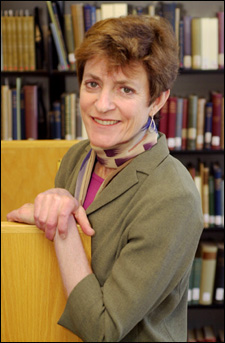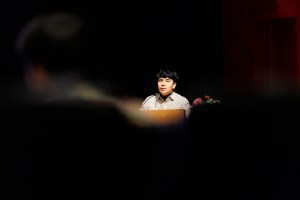Pioneering women’s historian joins FAS, Schlesinger:
Nancy Cott explores gender from both sides now

Nancy F. Cott, the Jonathan Trumbull Professor of American History, is recognized as a pioneer in the field of women’s history.
As Pforzheimer Foundation director of the Schlesinger Library at the Radcliffe Institute for Advanced Study, she guides one of the nation’s major resources on the lives of women.
So it’s something of a surprise to see that she’s teaching a course called “Men, Manhood, and Masculinity.”
Cott, who joined the Faculty of Arts and Sciences (FAS) last spring after a long career at Yale University, insists that she is not scuttling her academic interest for a radical change. Rather, she said, she is expanding her view of the history of women and gender.
“My own interests over these 25 years or so have been very much at one with the development of the field, in moving from uncovering women and enabling the ‘inarticulate’ to speak to understanding that gender is operative in all spheres of political, social, cultural life,” she said.
A ‘founding mother’
As a U.S. historian with a focus on women and gender, Cott has roamed the centuries and tackled a range of topics – from the roots of feminism to the politics of marriage – in her research and her seven books.
“Nancy is one of the ‘founding mothers’ of the field of American women’s history,” said Lizabeth Cohen, Howard Mumford Jones Professor of American Studies in the History Department. “Since her path-breaking first book, ‘The Bonds of Womanhood,’ in the late 1970s, she has continued to innovate – in helping conceptualize what happened to women after they secured the suffrage and in bringing legal history to bear on understanding women’s place in the institution of marriage, to name only a couple areas.”
Cott’s academic training in the late 1960s and early ’70s was rooted in what she calls the “new social history”: the then-revisionist work of telling the stories of ordinary people and giving voice to the previously inarticulate – many of them, of course, women.
Over the past three decades, her focus has shifted to encompass a broader view of social history, social order, and gender.
“I see gender operating as a social organizer that sorts people into groups and is frequently used by authorities to create forms of social order,” she said. “I am interested in the way personal consciousness and political order interact.”
Her most recent book, “Public Vows: A History of Marriage and the Nation” (Harvard University Press, 2000), probes that intersection of the personal and political.
“Marriage is thought of by most people as a familial, private kind of matter, but in fact I look at it in this book as a part of a public order,” she said.
Cott is less interested, in this book, in the private interactions between wives and husbands than in the government’s use of marriage as a way to organize social order – and the impact of this order on individuals’ consciousness.
“Whether one is married or not, the institution stands as a way of organizing [in people’s minds] what it means to be a grown-up man, what it means to be a grown-up woman in our society,” she said.
Of men and marriage
It was this view of marriage, which has been called groundbreaking, that led to Cott’s interest in men and masculinity. Exploring marriage as a public institution, she discovered that it placed unique responsibilities upon men as citizens. As heads of their households, men were charged with representing the household to the state.
“Before embarking on [this book], like many people in women’s history, I mainly thought of marriage as an institution that had, traditionally and historically, many constraints for women,” said Cott. The corollary to this assumption was that the institution provided freedom to men.
“But it wasn’t freedom, it was a position of obligation, to the state, to dependents,” she added.
Cott views the growing interest in masculinity – hers as well as others’ in the field – as another step in the development of a relatively young academic concentration that is moving from the study of women specifically to gender broadly and now, to the other side of the gender seesaw.
“Since gender is a relational system, it means that whenever you affect one side of what happens in gender roles, the other side is affected, too,” she said.
Sharing with the Schlesinger
Harvard’s Faculty of Arts and Sciences shares Cott with Radcliffe’s Schlesinger Library, where she is that institution’s first faculty director. It is a very conscious reflection of Radcliffe’s new identity as the Radcliffe Institute of Advanced Study that the director is a working academic.
“I see my role as linking the library more fully and robustly to the faculty and the students at Harvard, in FAS especially,” Cott said.
While students, both graduate and undergraduate, have long used the library, Cott wants to make them even more aware of the breadth of its resources, which are as varied as the women whose lives are chronicled there.
Cott, who was a member of the Yale faculty since 1975 and held its Sterling Professorship, Yale’s highest honor, credits the Schlesinger half of her appointment with luring her from New Haven to Cambridge.
“It’s a very major reason that I was interested in this job,” Cott said, adding that without a faculty position she would not have come.
Cott’s fond familiarity with the Schlesinger dates back to the early days of the women’s movement – and of her career. As a student at Brandeis University, where she did her graduate studies, she lived in Cambridge and found the library an invaluable resource for a women’s history course she taught at Wheaton College.
“It was because of this library that I was able to teach women’s history,” she said. “I’ve felt very indebted to this library. It’s been a crucial part of what I’ve relied on in the research field for three decades. The idea of heading it was enchanting to me.”
A tolerance for paradox
Having witnessed and even shaped the history of the study of women’s history, Cott has a unique perspective on the field and the students who engage with it.
Although the field has been in existence for the entire lives of the students she teaches today, public knowledge of women’s history is not much better now than it was 30 years ago, she said.
“It’s one of the big, big failings of the scholarship,” she said. “A lot of what the public has absorbed about women’s history is very knee-jerk and often extremely reductive.”
Too often, she said, the public’s view of women’s history is polarized: either they assume women were oppressed in the past, or they may know of certain great leaders.
“A truer way to tell an overview of women’s history would include both oppression and great triumphs – sometimes in the same women. There is a lot of paradox involved,” she said. “To … work in this field, one has to have a tolerance for paradox.”




